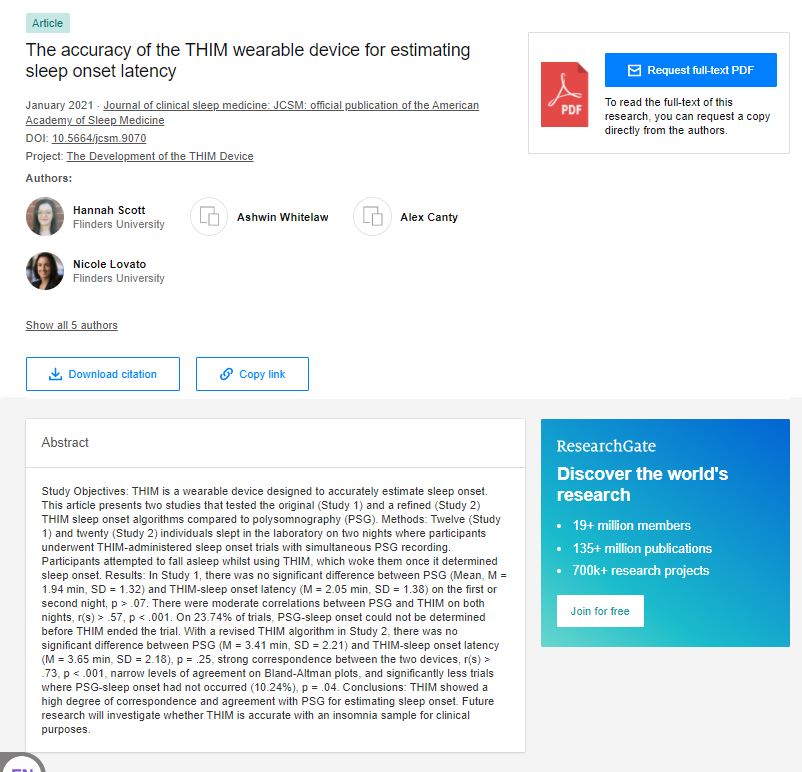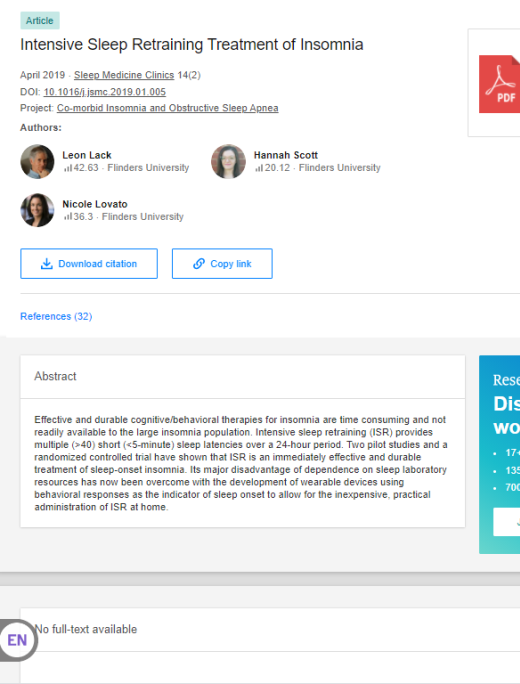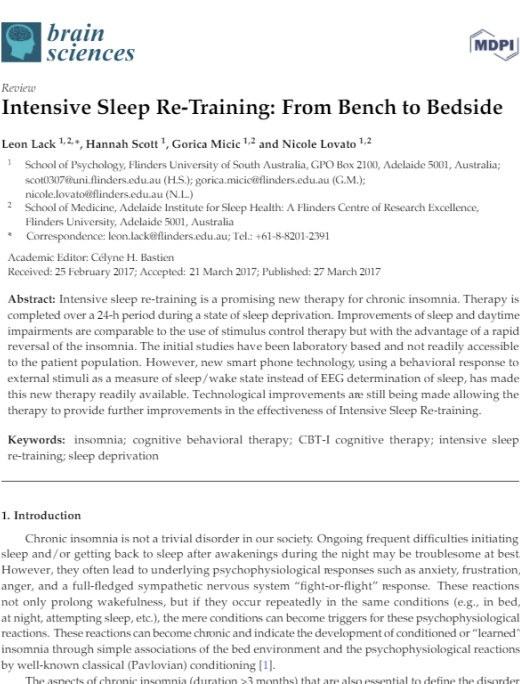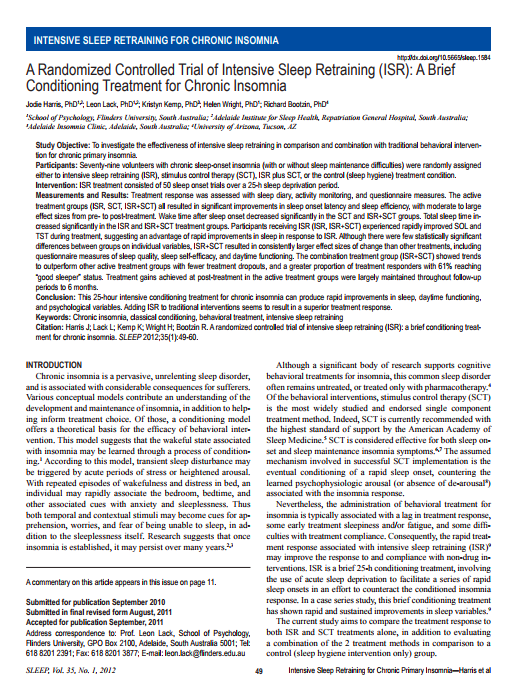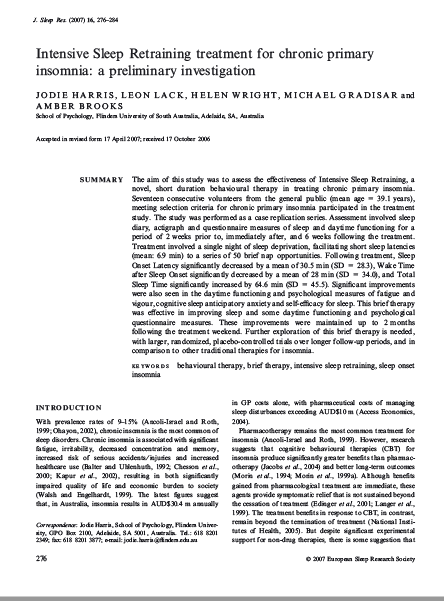Since 2007, the sleep conditioning technique of sleep re-training has been studied at the Sleep Laboratories of Flinders University (Australia). This research has shown significant improvement in sleep latency (time to fall asleep), wakefulness and sleep duration.
The Development and Accuracy of the THIM Wearable Device for Estimating Sleep and Wakefulness.
Scott H, Lovato N, Lack L. Nature and Science of Sleep. 13:39-53 Jan 2021
Objective:
To showcase the development of the THIM sleep tracking algorithm (Study 1) and the testing of its accuracy against polysomnography (PSG) with an independent sample of good and poor sleepers (Study 2).
Method:
Twenty-five (Study 1) and twenty (Study 2) healthy individuals with good or poor sleep (defined by scores on the Insomnia Severity Index) slept overnight in the sleep laboratory on one night. Participants slept from their typical bedtime to their typical wake up time with simultaneous recording from PSG, THIM, Fitbit and Actiwatch devices.
Conclusion:
Together, these studies suggest that THIM is capable of monitoring sleep and wake overnight in good and poor sleepers to a similar degree of accuracy as two of the most popular actigraphy devices available.
The accuracy of the THIM wearable device for estimating sleep onset latency.
Scott H, Whitelaw A, Canty A, Lovato N, Lack L. Journal of Clinical Sleep Medicine. Jan 2021
Objective:
To compare both the original THIM sleep onset algorithm and the refined (in 2020) version to polysomnography (PSG).
Method:
Twelve (Study 1) and twenty (Study 2) individuals slept in the laboratory on two nights where participants underwent THIM-administered sleep onset trials with simultaneous PSG recording.
Participants attempted to fall asleep whilst using THIM, which woke them once it determined sleep onset.
Conclusion:
THIM showed a high degree of correspondence and agreement with PSG for estimating sleep onset. Future research will investigate whether THIM is accurate with an insomnia sample for clinical purposes.
Intensive Sleep Retraining Treatment of Insomnia.
L Lack, H Scott, and N Lovato. Sleep Medicine Clinics 14(2) April 2019
Objective:
To allow for the inexpensive, practical administration of ISR at home using wearable devices.
Method:
Intensive sleep retraining (ISR) provides multiple (>40) short (<5-minute) sleep latencies over a 24-hour period. These are triggered via variable haptic feedback from a wearable device.
Conclusion:
Effective and durable cognitive/behavioral therapies for insomnia are time consuming and not readily available to the large insomnia population. Two pilot studies and a randomized controlled trial have shown that ISR is an immediately effective and durable treatment of sleep-onset insomnia.
Intensive Sleep Re-Training: From Bench to Bedside.
L Lack, H Scott, G Micic, and N Lovato. Brain Sciences 7 (4) March 2017
Objective:
To provide a highly effective, inexpensive, and readily accessible treatment of insomnia
Method:
ISR (Intensive Sleep RE-Training) combines many opportunities to fall asleep quickly (i.e., 20–25 min opportunity every 30 min across a 24 h period). Shortly after the patient falls asleep during a sleep opportunity (2–3 min after Stage 1 sleep onset), they are awoken. The little amount of sleep that the patient receives is not enough to relieve sleep pressure. Therefore, sleep pressure increases across the night, which causes the patient to fall asleep more quickly.
Conclusion:
Intensive sleep re-training (ISR) has strong empirical support from laboratory studies as a very effective treatment of chronic insomnia. Its initial main disadvantage was the expense and inaccessibility of an intensive laboratory procedure. That disadvantage appears to have been largely overcome by the development of an iPhone app, Sleep on Cue. It uses the failure to respond to an external stimulus as the indication of sleep onset and uses algorithms from the iPhone to administer the protocol of ISR, thus obviating the need for PSG recording and laboratory technicians. However, further improvements can be made with the use of a minimal finger movement response to a miniscule vibratory stimulus built into a small wearable device autonomous of the smartphone, such as the THIM device. This small wearable device would also facilitate research to further improve the effectiveness of this already promising ISR treatment of chronic insomnia.
A Randomized Controlled Trial of Intensive Sleep Retraining (ISR): A Brief Conditioning Treatment for Chronic Insomnia. J Harris, L Lack, K Kemp, H Wright, R Bootzin. SLEEP, Vol. 35, No. 1, 2012
Objective:
To investigate the effectiveness of intensive sleep retraining in comparison and combination with traditional behavioral intervention for chronic primary insomnia.
Method:
Seventy-nine volunteers with chronic sleep-onset insomnia (with or without sleep maintenance difficulties) were randomly assigned either to intensive sleep retraining (ISR), stimulus control therapy (SCT), ISR plus SCT, or the control (sleep hygiene) treatment condition. ISR treatment consisted of 50 sleep onset trials over a 25-h sleep deprivation period.
Conclusion:
Treatment response was assessed with sleep diary, activity monitoring, and questionnaire measures. The active treatment groups (ISR, SCT, ISR+SCT) all resulted in significant improvements in sleep onset latency and sleep efficiency, with moderate to large effect sizes from pre- to post-treatment.
Wake time after sleep onset decreased significantly in the SCT and ISR+SCT groups. Total sleep time increased significantly in the ISR and ISR+SCT treatment groups. Participants receiving ISR (ISR, ISR+SCT) experienced rapidly improved SOL andTST during treatment, suggesting an advantage of rapid improvements in sleep in response to ISR. Although there were few statistically significant differences between groups on individual variables, ISR+SCT resulted in consistently larger effect sizes of change than other treatments, including questionnaire measures of sleep quality, sleep self-efficacy, and daytime functioning. The combination treatment group (ISR+SCT) showed trends to outperform other active treatment groups with fewer treatment dropouts, and a greater proportion of treatment responders with 61% reaching “good sleeper” status.
Treatment gains achieved at post-treatment in the active treatment groups were largely maintained throughout follow-up periods to 6 months.
Intensive Sleep Retraining Treatment for Chronic Primary Insomnia: A Preliminary Investigation. J Harris, L Lack, H Wright, M Gradisar and A Brooks. European Sleep Research Society, J. Sleep Res., 16, 276–284, 2007
Objective:
The aim of this study was to assess the effectiveness of Intensive Sleep Retraining, a novel, short duration behavioural therapy in treating chronic primary insomnia. Seventeen consecutive volunteers from the general public (mean age = 39.1 years), meeting selection criteria for chronic primary insomnia participated in the treatment study. The study was performed as a case replication series.
Method:
Assessment involved sleep diary, actigraph and questionnaire measures of sleep and daytime functioning for a period of 2 weeks prior to, immediately after, and 6 weeks following the treatment. Treatment involved a single night of sleep deprivation, facilitating short sleep latencies (mean: 6.9 min) to a series of 50 brief nap opportunities.
Conclusion:
Following treatment, Sleep Onset Latency significantly decreased by a mean of 30.5 min (SD = 28.3), Wake Time after Sleep Onset significantly decreased by a mean of 28 min (SD = 34.0), and Total Sleep Time significantly increased by 64.6 min (SD = 45.5). Significant improvements were also seen in the daytime functioning and psychological measures of fatigue and vigour, cognitive sleep anticipatory anxiety and self-efficacy for sleep. This brief therapy was effective in improving sleep and some daytime functioning and psychological questionnaire measures. These improvements were maintained up to 2 months following the treatment weekend.



